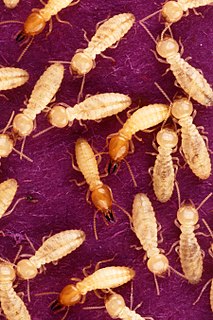
Termites are eusocial insects that are classified at the taxonomic rank of infraorder Isoptera, or as epifamily Termitoidae within the order Blattodea. Termites were once classified in a separate order from cockroaches, but recent phylogenetic studies indicate that they are related to cockroaches, as they are the sister group to wood eating cockroaches of the genus Cryptocercus. Previous estimates suggested the divergence took place during the Jurassic or Triassic. More recent estimates suggest they have an origin during the Late Jurassic, with the first fossil records in the Early Cretaceous. About 3,106 species are currently described, with a few hundred more left to be described. Although these insects are often called "white ants", they are not ants, and are not closely related to ants.

Nasutitermes is a genus of termites. It consists of the following species:

Nasutitermes corniger is a species of arboreal termite that is endemic to the neotropics. It is very closely related to Nasutitermes ephratae. The species has been studied relatively intensively, particularly on Barro Colorado Island, Panama. These studies and others have shown that the termite interacts with many different organisms including a bat that roosts in its nest and various species of ants that cohabit with the termite.
Postelectrotermes militaris is a species of drywood termite of the genus Postelectrotermes. It is native to India and Sri Lanka. It is a serious pest of tea.
Coptotermes gaurii, is a species of subterranean termite of the genus Coptotermes. It is native to South India and Sri Lanka. It is a serious pest of tea in Sri Lanka.
Heterotermes ceylonicus, is a species of subterranean termite of the genus Heterotermes. It is native to India and Sri Lanka. It is a wood destroying termites, which damage to logs, wooden structures of both natural and man-made such as tree stumps of Gravellia plants and tea plantations. It can be also found in mounds of Hypotermes obscuriceps and Hevea brasiliensis.
Termitogeton umbilicatus, is a species of subterranean termite of the genus Termitogeton. It is endemic to Sri Lanka and can be seen in forests, plains, hills and human vegetation of higher elevations.
The Fungus-growing termite,, also known as South Asian wood-destroying termite, is a small species of earth dwelling termite of the genus Odontotermes. It is native to India and Sri Lanka.
Odontotermes globicola is a species of small termite of the genus Odontotermes. It is native to India, Malaysia and Sri Lanka. It is found under flower pots and decaying logs. They construct small chambered nest with spherical combed termitaria.
Hypotermes obscuriceps, is a species of termite of the genus Hypotermes. It is native to India, Sri Lanka and Vietnam. It constructs a termitaria and is a pest of tea.
Speculitermes sinhalensis, is a species of termite of the genus Speculitermes. It is native to India and Sri Lanka. It was first found from Vavuniya. They are typical subterranean soil humus feeding termites, which can be found under logs, decaying trees, rocks.
Nasutitermes ceylonicus, is a species of termite of the genus Nasutitermes. It is found in Sri Lanka. It is a pest of tea and coconut. It damages numerous wooden constructions, and timber in buildings.
Nasutitermes lacustris, is a species of termite of the genus Nasutitermes. It is found in India and Sri Lanka. This species builds nests on branches of forest trees and can be found in stems of trees like Anacardium, Hevea and Elaeocarpus.
Nasutitermes oculatus, is a species of termite of the genus Nasutitermes. It is found in India and Sri Lanka. It lives within the stems of Dendrocalamus giganteus.
Ceylonitermellus hantanae, is a species of termite of the genus Ceylonitermellus. It is endemic to Sri Lanka, first described from Hanthana Mountain Range area. It is a soil-dwelling and soil-feeding termite species.
Ceylonitermellus kotuae, is a species of termite of the genus Ceylonitermellus. It is endemic to Sri Lanka, first described from Kotuwa area of Galle. It is a soil-dwelling and soil-feeding termite species.
Microcerotermes heimi, is a species of small termite of the genus Microcerotermes. It is found from Maharashtra area of India and from Sri Lanka. It can be found from forests, in dead stumps and under bark of trees.
Dicuspiditermes nemorosus, is a species of small termite of the genus Dicuspiditermes. It is found in Sri Lanka, India, Malaysia and Borneo. The species is known to build three different types of mounding nests, where two termitaria have single protruding nest structure and third nest type is typified by several protruding nest all connected at the base.
Pericapritermes speciosus, is a species of small termite of the genus Pericapritermes. It is found in Sri Lanka and Borneo.


